Related Research Articles

Chaves is a city and a municipality in the north of Portugal. It is 10 km south of the Spanish border and 22 km south of Verín (Spain). The population of the entire municipality in 2011 was 41,243, in an area of 591.23 km2. The municipality is the second most populous of the district of Vila Real. With origins in the Roman civitas Aquæ Flaviæ, Chaves has developed into a regional center. The urban area or city proper has 17,535 residents (2001).
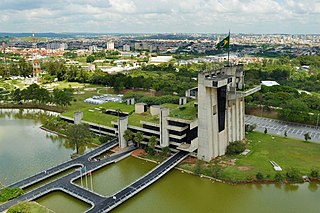
Sorocaba is a municipality in the interior of the state of São Paulo, Brazil. With over 723,000 inhabitants, it is the seventh-largest city in the state and the second-largest outside the Greater São Paulo region, ranking behind only Campinas. It forms its own Metropolitan Region of Sorocaba, comprising 27 municipalities with a total population of 2 million inhabitants, the 15th most populous in Brazil.

Barueri is a Brazilian municipality in the State of São Paulo located in the northwestern part of the Metropolitan Region of São Paulo. The population is 276,982 in an area of 65.70 km2 (25.37 sq mi).

Itapevi is a Brazilian municipality in the state of São Paulo located in the western part of the Greater São Paulo metropolitan area. The population is 240,961 in an area of 82.7 km2.
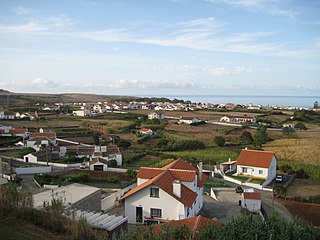
Vila do Porto is the single municipality, the name of the main town and one of the civil parishes on the island of Santa Maria, in the Portuguese archipelago of Azores. Its nearest neighbor, administratively, is the municipality of Povoação on the southern coast of São Miguel, and it is physically southwest of the islets of the Formigas. The population in 2021 was 5,408, in an area of 96.89 km2 (37.41 sq mi).

Vila Franca do Campo is a town and municipality in the southern part of the island of São Miguel in the Portuguese Autonomous Region of the Azores. The population of the municipality was 11,229 in 2011, in an area of 77.97 km². The town proper, which incorporates the urbanized parishes São Miguel and São Pedro, has 4100 inhabitants.

Alandroal is a municipality in the Portuguese district of Évora located on the eastern frontier with Spain along the right margin of the Guadiana River in the Central Alentejo region. It is located 341 metres (1,119 ft) above sea level, northeast of Évora and southeast of Estremoz. The population in 2011 was 5,843, in an area of 542.68 km2.

Cartaxo is a municipality in the district of Santarém in continental Portugal. The population in 2011 was 24,462, in an area of 158.17 km2. The urbanized centre of Cartaxo had a population of 9,507 in 2001.
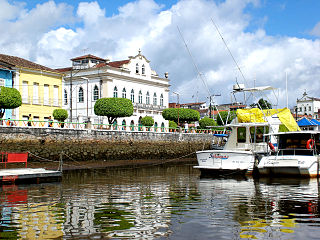
Valença is a Brazilian city in the state of Bahia and has an estimated population of 97,233. It is visited by tourists because it is the main access to the island of Ilha de Tinharé, famous for the town of Morro de São Paulo.
The São Francisco Ridge is a topographic elevation in the Brazilian Highlands, situated in the south of the cities of Votorantim and Sorocaba, state of São Paulo, Brazil.
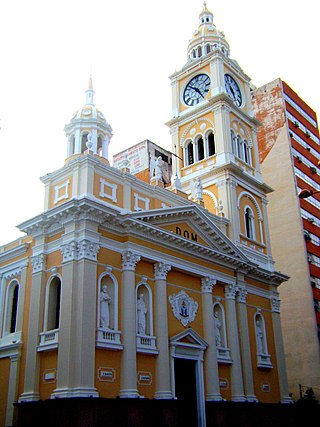
The Sorocaba Metropolitan Cathedral or Metropolitan Cathedral of "Nossa Senhora da Ponte", home of Archdiocese of Sorocaba, located in the Plaza Coronel Fernando Prestes in downtown area of the city of Sorocaba, São Paulo, Brazil. It was built over 200 years ago.

Marco da Silva Ignácio, commonly known as Marquinho, is a Brazilian footballer. Mainly an attacking midfielder, he can also play as a wing back.
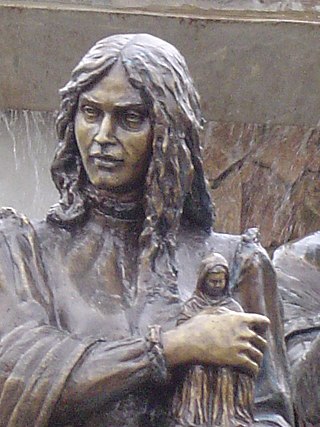
Susana Dias was a bandeirante who, along with her son captain André Fernandes, founded the city of Parnahyba in the Captaincy of São Vicente, which would become the modern-day city of Santana de Parnaíba, São Paulo, Brazil.

The interior of São Paulo is an informal term to describe the zone that covers the entire area of the state of São Paulo outside the Metropolitan Region and the coast of São Paulo. The interior stands out for having a very rich cultural set, including several unique accents different from those of the capital and the coast.

Bartolomeu Bueno da Silva, also known as Anhanguera was a bandeirante from the state of São Paulo. At 12 years old, he went to accompany his father, also named Bartolomeu Bueno da Silva, in expeditions into the rural areas of the Captaincy of São Vicente, corresponding to the territory of the moden-day state of Goiás. With the discovery of gold in Minas Gerais, he founded the city of Sabará and, later on, the cities of São João do Paraíso and Pitangui, where he was named an assistant of the district. In 1720, he returned to his hometown of Santana de Parnaíba and created a presentation to Dom João V of Portugal asking for permission to return to Goiás, where his father had found gold. In return, Dom João asked for the right to demand pay for people traversing rios on the way to the mines in Goiás. The offer was accepted, and another expedition began to be organized.
References
- ↑ "History of the City of Sorocaba". Municipality of Sorocaba. Retrieved 29 March 2014.
- ↑ "Largo São Bento". Sorocaba City Interactive. 2012. Archived from the original on 12 May 2014. Retrieved 29 March 2014.
- ↑ "Get to know your city: Sorocaba" . Retrieved 29 March 2014.
- ↑ "History of the City of Sorocaba". Municipality of Sorocaba. Retrieved 29 March 2014.
- ↑ de Oliveira Rampim, João Alberto. "Baltazar Fernandes and the city of Sorocaba". Archived from the original on 2 April 2015. Retrieved 29 March 2014.
- ↑ Hachel, Karin. "Abraomas Kann - Inaugural Address". History Institute, Geographic and Genealogical Sorocaba (in Portuguese). Archived from the original on 2 May 2014. Retrieved 29 March 2014.
- ↑ Carvalho, Mario Cesar (5 September 2004). "Bandeirantes had Jewish origin". Folha De S.Paulo. Retrieved 29 March 2014.